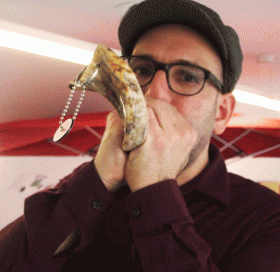“on.tour” in Prison
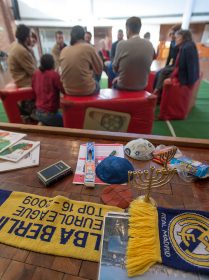
Guides discussing exhibition cubes and hands-on material with inmates; Jewish Museum Berlin, photo: Svea Pietschmann
I had hardly returned from the summer holidays this year when I went straight to “jail!” But don’t worry, my criminal record still has zero entries. Rather, my visit to prison occurred in the context of our so-called “Prison Week.” This was where our mobile education initiative, “on.tour – The JMB tours schools,” visited the juvenile detention centers at Plötzensee and Neustrelitz. These two days gave me the opportunity to gain insight into the young prisoners’ everyday lives. The experiences I had there were incredibly interesting and corrected some ideas I had previously had about correctional facilities.
Cold – grey – dreary: when you think of jail, it’s not the most inviting pictures that come to mind. I was all the more astonished then, when I walked into the juvenile detention center at Neustrelitz. The “luxury jail”, as it’s known to insiders, is set directly next to a forested area. The facility itself is very green as well: generous grassy lawns, small trees, and a handful of flowerbeds tended by the inmates. On the way to the one-story cell blocks that are scattered across the compound you pass by a number of wooden benches and tables. There’s even a little pond with fish. If there weren’t the barbed wire on top of the prison wall, you could mistake the facility for a country boarding school. This wouldn’t happen at the juvenile detention center at Plötzensee. The enormous complex there is located in the middle of the city and, with its massive brick buildings and high prison walls, elicits a feeling of confinement.
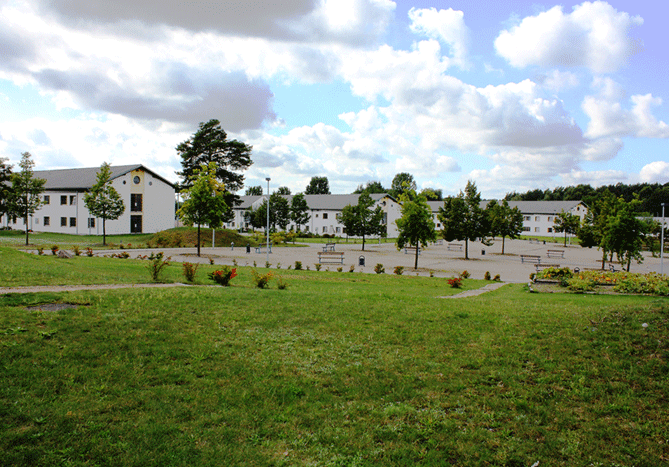
Prison grounds of juvenile detention center at Neustrelitz; Jugendanstalt Neustrelitz, photo: Steffen Bischof
In both Neustrelitz and Plötzensee we encountered prisoners in front of the entrances to the cell blocks. The boys were between 14 and 23 years old. They wore white muscle shirts, blue sweaters, and sweatpants, with black sneakers – no stripes or orange jumpsuits of the kind we know from movies. The young prisoners eagerly carried the exhibition cubes with integrated display cases into the workshop space for us. What struck me at both places was the respectful interaction between prison personnel and inmates. One guard told me that he sees himself there as an educator and is thus an important caregiver for the boys, who are for the most part still teenagers.
On the first day our on.tour guide, Arnon Hampe, started the morning off with a special round of introductions: each participant would introduce himself from the perspective of another person. Arnon began and talked about himself from the perspective of his best friend. When he was finished, no one dared to pick up the baton. So I found myself taking the turn. Like Arnon I slipped into the role of my best friend for a few minutes. Granted, it was a bit of a struggle to play someone else but at the same time to talk about oneself on a personal level. But after a while it became a lot of fun. The exciting thing about this method is that you gain a bit of internal distance, so that you can describe yourself with a more objective eye. After me there was another silence. I encouraged the youth sitting beside me to introduce himself next and that got the ball rolling.
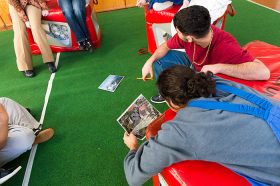
Inmate looking at a picture of the Jewish Museum Berlin; Jewish Museum Berlin, photo: Svea Pietschmann
What impressed me the most was how openly the boys spoke about their lives. They didn’t shy away from telling us very personal things about the offenses they committed and the consequences they faced. “I find it hard to deal with, that he’s sitting in jail and I’m alone at home with the kids,” said Mario* in the role of his fiancée Jenny*. “I miss him.” Mario is spending almost two years at Neustrelitz for robbery and assault. Most of them are there for similar reasons. Drug offenses are among the most common. Felix* has to serve seven months for dealing drugs. During the afternoon workshop he soberly declared: “Compared to the other things I find my punishment pretty hard. If it does any good to be here, it’ll be that I definitely won’t sell that stuff anymore.”
After lunch in the dining hall (the food was surprisingly good – better than many a university cafeteria), the group discussed the exhibition cubes and various Jewish objects they’d been presented with. When I carefully unrolled a mini Torah on the floor, the prisoners were fascinated by the scroll’s make and scale. Throughout the day I noticed that the stories of why the boys were there receded further and further into the background. Many of them came across as sympathetic and likeable and were very interested in religion and culture. I experienced the same thing the next day at the detention center in Plötzensee. Here too, the prisoners were extremely inquisitive. The way that a 19-year-old prisoner called Mike*, for instance, asked a question suggested a considerable prior knowledge on the subject. When I asked him if he was particularly interested in religion, he replied that he often takes out books on the subject from the center’s library. At the moment he was reading a book about the religious-historical relationship between Judaism and Christianity, which he showed me in the next break. I was very impressed.
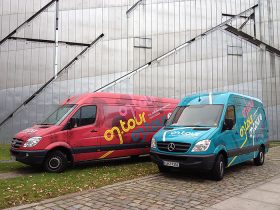
Beside prisons our buses navigate each year to lots of schools throughout Germany ; Jewish Museum Berlin, photo: Stefan Schöbinger
After those two days I didn’t have the smallest doubt that the young prisoners very much enjoyed the on.tour program, which offered a valuable and welcome change from their usual everyday routines. Many of the boys expressed their appreciation for the workshop as we concluded it and let us know that they would definitely like to visit the Jewish Museum Berlin after their release. For Issam* that day can’t come quickly enough. While I was loading up the exhibition, he asked me with a mischievous smile whether we couldn’t hide him in the back of the bus and take him with us. I smiled back, shrugged my shoulders and told him I didn’t think that would work. But as soon as he’s released, I assured him, he would be most welcome to come visit us at the museum.
*names changed by the author
When you visit a prison, David Studniberg recommends that you don’t forget to take a watch, since smart- and other mobile phones have to be handed over at the entrance.
